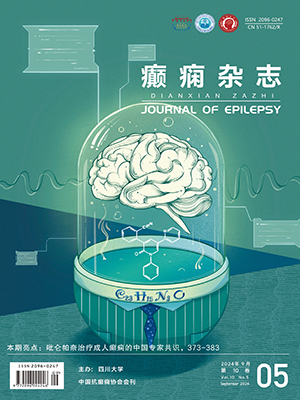| 1. |
Bertran F. L’épilepsie aujourd’hui [Epilepsy today]. Rev Infirm, 2018, 67(243): 14-16.
|
| 2. |
Thijs RD, Surges R, O'Brien TJ, et al. Epilepsy in adults. Lancet, 2019, 393(10172): 689-701.
|
| 3. |
Ding D, Zhou D, Sander JW, et al. Epilepsy in China: major progress in the past two decades. Lancet Neurol, 2021, 20(4): 316-326.
|
| 4. |
Hampel KG, Garces-Sanchez M, Gomez-Ibanez A, et al. Desafios diagnosticos en epilepsia [Diagnostic challenges in epilepsy]. Rev Neurol, 2019, 68(6): 255-263.
|
| 5. |
RavizzaT, Onat FY, Brooks-Kayal AR, Depaulis A, et al. WONOEP appraisal: biomarkers of epilepsy-associated comorbidities. Epilepsia, 2017, 58(3): 331-342.
|
| 6. |
Ravizza T, Vezzani A. Pharmacological targeting of brain inflammation in epilepsy: therapeutic perspectives from experimental and clinical studies. Epilepsia Open, 2018, 3(Suppl 2): 133-142.
|
| 7. |
Whitlock JH, Soelter TM, Williams AS, et al. Liquid biopsies in epilepsy: biomarkers for etiology, diagnosis, prognosis, and therapeutics. Hum Cell, 2022, 35(1): 15-22.
|
| 8. |
da Rosa MI, Simon C, Grande AJ, et al. Serum S100B in manic bipolar disorder patients: systematic review and meta-analysis. J Affect Disord, 2016, 206: 210-215.
|
| 9. |
Astrand R, Undén J. Clinical use of the calcium-binding s100b protein, a biomarker for head injury. Methods Mol Biol, 2019, 1929: 679-690.
|
| 10. |
Calik M, Abuhandan M, Kandemir H, et al. . Interictal serum S-100B protein levels in intractable epilepsy: a case-control study. Neurosci Lett, 2014 , 13(8): 58-61.
|
| 11. |
王晶, 殷亮, 吕涌涛, 冯肖亚. S100B在癫痫患者脑脊液和血清中的表达. 实用医学杂志, 2016, 32(20): 3422-3424.
|
| 12. |
Liang KG, Mu RZ, Liu Y, Jiang D, et al . Increased serum s100b levels in patients with epilepsy: a systematic review and meta-analysis study. Front Neurosci, 2019, 16(5): 13: 456.
|
| 13. |
Li Y, Wang Z, Zhang B, et al . Cerebrospinal fluid ubiquitin C-terminal hydrolase as a novel marker of neuronal damage after epileptic seizure. Epilepsy Res, 2013, 2, 103(2-3): 205-210.
|
| 14. |
Asadollahi M, Simani L. The diagnostic value of serum UCHL-1 and S100-B levels in differentiate epileptic seizures from psychogenic attacks. Brain Res, 2019, 1704: 11-15.
|
| 15. |
Pollard JR, Eidelman O, Mueller GP, et al. The TARC/sICAM5 ratio in patient plasma is a candidate biomarker for drug resistant epilepsy. Front Neurol, 2013, 3(1): 181.
|
| 16. |
Cabrera-Reyes EA, Limón-Morales O, Rivero-Segura NA, et al. Prolactin function and putative expression in the brain. Endocrine, 2017 , 57(2): 199-213.
|
| 17. |
Wang YQ, Wen Y, Wang MM, et al. Prolactin levels as a criterion to differentiate between psychogenic non-epileptic seizures and epileptic seizures: a systematic review. Epilepsy Res, 2021 , 169: 106508.
|
| 18. |
Grafe LA, Bhatnagar S. Orexins and stress. Front Neuroendocrinol, 2018 , 51: 132-145.
|
| 19. |
Razavi BM, Farivar O, Etemad L, et al. Suvorexant, a dual orexin receptor antagonist, protected seizure through interaction with GABAA and glutamate receptors. Iran J Pharm Res, 2020, 19(2): 383-390.
|
| 20. |
Çikriklar HI, Kotan D, Yücel M, Ceylan M, et al. The role of Orexin-A levels in epileptic seizure. Neurosci Lett, 2020, 24(8): 734: 135097.
|
| 21. |
Ng MC. Orexin and epilepsy: potential role of rem sleep. Sleep, 2017, 1(3): 1-3.
|
| 22. |
Roundtree HM, Simeone TA, Johnson C, et al. Orexin receptor antagonism improves sleep and reduces seizures in kcna1-null mice. Sleep, 2016, 39(2): 357-368.
|
| 23. |
Samzadeh M, Papuć E, Furtak-Niczyporuk M, et al. Decreased cerebrospinal fluid orexin-a (hypocretin-1) concentrations in patients after generalized convulsive status epilepticus. J Clin Med, 2020 , 19(10): 3354.
|
| 24. |
Rana A, Musto AE. The role of inflammation in the development of epilepsy. J Neuroinflammation, 2018, 15(1): 144.
|
| 25. |
Alyu F, Dikmen M. Inflammatory aspects of epileptogenesis: contribution of molecular inflammatory mechanisms. Acta Neuropsychiatr, 2017 , 29(1): 1-16.
|
| 26. |
Vezzani A, Aronica E, Mazarati A, et al. Epilepsy and brain inflammation. Exp Neurol, 2013, 244: 11-21.
|
| 27. |
Vezzani A. Epilepsy and inflammation in the brain: overview and pathophysiology. Epilepsy Curr, 2014 , 14(Suppl 1): 3-7.
|
| 28. |
Sanz P, Garcia-Gimeno MA. Reactive glia inflammatory signaling pathways and epilepsy. Int J Mol Sci, 2020 , 21(11): 4096.
|
| 29. |
Aronica E, Ravizza T, Zurolo E, et al. Astrocyte immune responses in epilepsy. Glia, 2012 , 60(8): 1258-1268.
|
| 30. |
Vezzani A, Balosso S, Ravizza T. Neuroinflammatory pathways as treatment targets and biomarkers in epilepsy. Nat Rev Neurol, 2019, 15(8): 459-472.
|
| 31. |
Vega-García A, Feria-Romero I, García-Juárez A, et al. Cannabinoids: a new perspective on epileptogenesis and seizure treatment in early life in basic and clinical studies. Front Behav Neurosci, 2021, 12(1): 14: 610484.
|
| 32. |
Alapirtti T, Lehtimäki K, Nieminen R, et al. The production of IL-6 in acute epileptic seizure: a video-EEG study. Neuroimmunol, 2018, 316(15): 50-55.
|
| 33. |
Kamaşak T, Dilber B, Yaman SÖ, et al. HMGB-1, TLR4, IL-1R1, TNF-α, and IL-1β: novel epilepsy markers? Epileptic Disord, 2020, 22(2): 183-193.
|




